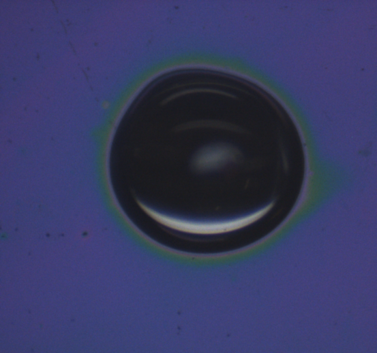
My research activity focuses on polymer thin layers, from the development of new architectures to functional properties, to control properties at interfaces, wetting, friction, adhesion. We also explore applications in microfluidics, optics and plasmonics which are less usual for polymer thin films. We are interested in polymer thin films, both for fundamental science and for technological and application aspects.
Mon activité de recherche porte sur les couches minces de polymères, du développement de nouvelles architectures aux propriétés fonctionnelles, pour piloter les propriétés aux interfaces, mouillage, frottement, adhésion. Nous explorons également les applications en microfluidique, en optique et plasmonique qui sont moins habituelles pour les couches minces de polymères. On s’intéresse aux couches minces de polymères, aussi bien pour la science fondamentale que pour les aspects technologiques et applicatifs.

Hydrogel thin films

Hydrogel films are networks of hydrophilic polymers cross-linked to each other and grafted onto a substrate. Hydrogel thin films have the advantage of being multi-scale and multi-functional. The network structure provides an additional degree of freedom in the direction perpendicular to the substrate. Hydrogel films therefore allow for greater variability, in terms of thickness, architecture and stimulable properties.
Langmuir 2015, 31, 11516-11524. https://doi.org/10.1021/acs.langmuir.5b02948
ACS Appl. Mat. Interfaces 2016, 8, 11729-11738. https://doi.org/10.1021/acsami.6b00446
ACS Appl. Mat. Interfaces 2016, 8, 24870–24879. https://doi.org/10.1021/acsami.6b07189
Langmuir 2021, 37, 8585-8593. https://doi.org/10.1021/acs.langmuir.1c01165
Langmuir 2025, 41, 2400-2410. https://doi.org/10.1021/acs.langmuir.4c04025

Polymer brushes

Polymer brushes are the simplest and most effective approach to modify surface properties with a grafted polymer monolayer. We have exploited the two strategies of « grafting from » and « grafting onto » by making the most of either method.
Langmuir 2007, 23, 5769-5778. https://doi.org/10.1021/la063450z
J. Polymer Sci. Part A: Polym. Chem. 2008, 46, 4305-4319. https://doi.org/10.1002/pola.22726
Macromolecules 2008, 41, 8721-8728. https://doi.org/10.1021/ma8018798
Polymers 2020, 12, 153. https://doi.org/10.3390/polym12010153

Wetting and Friction

The exploitation of functional properties of grafted hydrogel thin films requires a good understanding of their mechanical properties. Hydrogel films are hydrophilic polymer networks containing a lot of water (up to 80-90% by volume), and therefore fragile. The study of hydrogel films under mechanical and frictional stress or in adhesive contacts allows an understanding of the damage mechanisms and the optimization of the stability and durability of the films.
Soft Matter 2016, 12, 8049-8058. https://doi.org/10.1039/C6SM01448H
Langmuir 2018, 34, 9617-9626. https://doi.org/10.1021/acs.langmuir.8b01466
Langmuir 2018, 34, 15238-15244. https://doi.org/10.1021/acs.langmuir.8b03206
Soft Matter 2020, 16, 6539-6548. https://doi.org/10.1039/D0SM00641F
Soft Matter 2023, 27, 5169-5178. https://doi.org/10.1039/D3SM00490B
Soft Matter 2024, 30, 5933-5944. https://doi.org/10.1039/D4SM00313F
Soft Matter 2025, 21, 2529-2540. https://doi.org/10.1039/D4SM01439A

Adhesion and Bioadhesion

In the development of new materials and biomaterials, the understanding of adhesion mechanisms in aqueous immersed environments is essential. This requires both a fine characterization (mechanical approach of contact thanks to a probe-tack experimental device) and a good adjustment of the specific molecular interactions (electrostatic interactions, hydrogen bonds, hydrophobic interactions). We study the adhesive properties between synthetic hydrogels and model surfaces functionalized by ad hoc polymer thin films.
Soft Matter 2012, 8, 8184-8193. https://doi.org/10.1039/C2SM25868D
Macromolecules 2018, 51, 7556–7566. https://doi.org/10.1021/acs.macromol.8b01063
Adv. Mater. 2019, 31, 1808179. https://doi.org/10.1002/adma.201808179
Macromolecules 2019, 52, 3852-3862. https://doi.org/10.1021/acs.macromol.8b02696

Microfluidic actuators

Thermo-responsive hydrogels are used as autonomous micro-actuators that are integrated in lab-on-a-chip. Hydrogel microcages swell/collapse on demand with a small temperature change to encapsulate single cells. In our case, the grafting and patterning of the hydrogels are performed before the microfabrication of the chip, which undeniably offers a better control of the synthesis, a better reproducibility and no chemical pollution that prevented a biotechnological breakthrough until now.
Patent Number FR1251722. 2012. “Microchannel with an opening and/or closing and/or pumping device”.
Patent Number EP 21305027.1. 2021. “Analysis of cells and/or organelles in hydrogel cages”.
Nature Microsyst. Nanoeng. 2018, 4, 17069. https://doi.org/10.1038/micronano.2017.69

Electrochemical biosensors

Flexible and portable electrochemical biosensors allowing high sensitivity and selectivity of target molecules are developed. A key step in the design of an electrochemical biosensor is the immobilization of bioreceptors on the detection electrode for the molecular recognition of the target. The idea is to use hydrogels as an intermediate layer to increase the density of bioreceptors and the sensitivity of the biosensor. Collaboration with Cyrine Slim and Sophie Griveau from Chimie ParisTech PSL.
Langmuir 2020, 36, 827–836. https://doi.org/10.1021/acs.langmuir.9b02031
Electrochimica Acta 2025. https://doi.org/10.1016/j.electacta.2025.146361

Stimuli-responsive photonic crystals

We develop a new generation of photonic crystals with actuatable functions. This is made possible by finely controlling the chemistry and architecture of stimulable hydrogels. The idea is to exploit the platform of nano- and micro-structures of grafted hydrogels to design new photonic crystals in several dimensions: 1D, 2D and 3D. The thermo-responsive properties of hydrogels allow to modulate spectrally on demand the photonic crystals.
